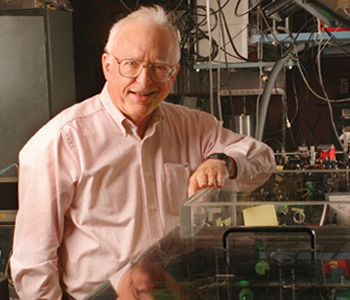After Image
OPN Talks with John L. Hall
Our conversation with John L. Hall, Nobel Laureate and keynote speaker at Frontiers in Optics.

After John Hall earned his Ph.D. in physics from the Carnegie Institute of Technology (now Carnegie Mellon University) in 1961, he found himself procrastinating on his postdoctoral application to the National Research Council. He was pondering how to respond to an essay question about why he wanted the opportunity. Finally, he scribbled the words “Physics is fun” on the form—and won the position that led to his career in precision measurement science.
“In spite of having enjoyed being a Boy Scout, I wonder if I have learned one of their slogans a bit wrong,” Hall says. “My whole life is a story that shows that being under-prepared can have advantages.” He was also unprepared on the night, 45 years later, when he received an important phone call from the Royal Academy, which was contacting him to tell him that he had won the 2005 Nobel Prize in Physics. His wife, Lindy, hung up the phone, as she imagined the call to be a Central American phone scam, which was a common nuisance at that time. Hall remembers: “On their next call, one could hear shouting, ‘No, no, don’t hang up—this is important!’”
The unexpected prize came as a result of Hall’s work at JILA and Theodor Hänsch’s work at the Ludwig-Maximilians University of Munich. (It also recognized Roy Glauber for his work in quantum physics.) Hall and Hänsch were acknowledged “for their contributions to the development of laser-based precision spectroscopy, including the optical frequency comb technique.” This breakthrough technique may be translated into important applications in highly accurate master clocks and global positioning systems.
Hall credits the advances of separate research teams on related work—from the development of the femtosecond laser to advances in frequency stabilization and readout metrologies—as well as friendly teamwork with Hänsch as important factors leading to the development of the technique. “During this intense run for the comb, the interactions between the Munich and JILA teams were, well, competitive, yes, but also very much cooperative and collaborative,” Hall said. “Each advance in each lab was shared with the other team.”
Another highlight of Hall’s career is winning OSA’s Charles Hard Townes Award and being presented the award by Townes himself. “My personal all-time hero is Professor Charles Townes, who has been the leader in all the scientific fields I’ve tried so far.”
By his own account, Hall himself is living in “semi-retirement.” He retired from NIST three years ago, but continues to work at his consulting company, Hall Stable Lasers LLC; the world headquarters is located just a short walk from his home—in the room located above his garage. There, Hall spends much of his time testing laboratory software in simulation before applying it to his ongoing Kennedy-Thorndike experiment at JILA.
He also works with a local Colorado start-up on the “airport sniffer” problem, Hall’s nickname for advanced chemical scanning; the company’s first patent was recently issued for this technology.
And that’s just his day job. Hall also continues to deliver lectures around the world. Fortunately, he is able to mix business with pleasure and often squeezes in a vacation with his wife on his journeys, the most recent of which included a two-week catamaran cruise of eight Greek islands.
A little closer to home, he enjoys visiting local schools with Lindy, a former schoolteacher. “I can link up pretty well with the few young geeks-to-be—perhaps with thick wire-rim glasses,” he says. “Keeping and enhancing these kids’ interest in science is fundamentally important to our country’s future.”
Hall is a strong believer in science education at all levels and says that today’s modern age of constant entertainment does not lend itself to producing future scientists. “Entertainment is too readily available—some kids even have a TV in their own room—and I’m afraid an affluent society is not well-placed to raise curious and capable engineers and physical scientists,” he says. “In my humble opinion, many young kids are damaged by being denied the chance to ‘figure stuff out,’ to use [Richard] Feynman’s words.”
In his plenary address this month at OSA’s annual meeting, Hall will touch on various approaches to research. “I will try to show the utility of an open and long-term systematic approach to research, where the entirety of the program has reasonable unity and inner utility, but where ‘crazy ideas’ can find a comfortable home as well.” His talk will also focus on the many uses of the optical frequency comb, including its application in atomic clocks. “We have now added several decades’ precision to the comparison of optical frequencies produced by different atomic clock-works,” he says. “Finding these frequency ratios to be constant in time, or to be changing in time, will have profound philosophical ramifications. I just can’t wait!”
John Hall will deliver the plenary session keynote address, “The Optical Frequency Comb: A Remarkable Tool with Many Uses,” at OSA’s Annual Meeting, Frontiers in Optics, September 16-20 in San Jose, Calif. For more information, visit www.frontiersinoptics.org.
Log in or become a member to view the full text of this article.
This article may be available for purchase via the search at Optica Publishing Group.
Optica Members get the full text of Optics & Photonics News, plus a variety of other member benefits.
